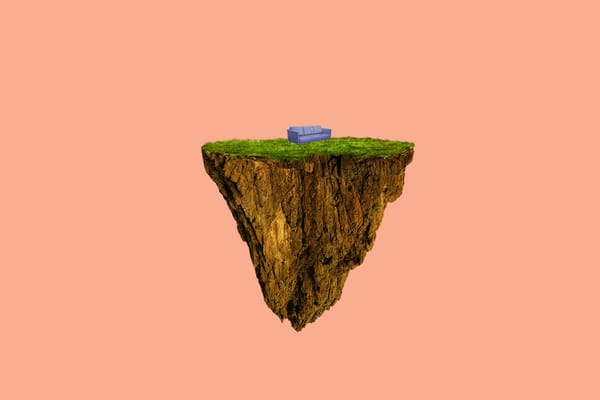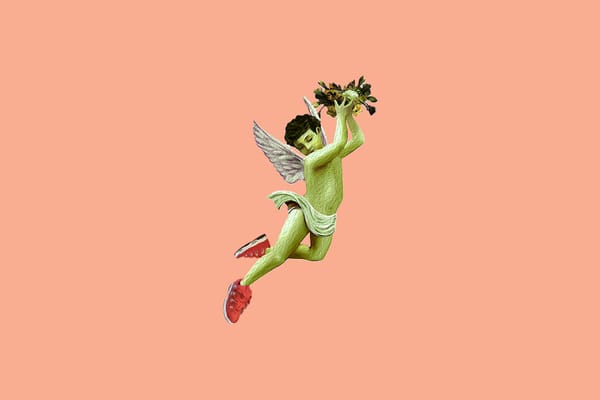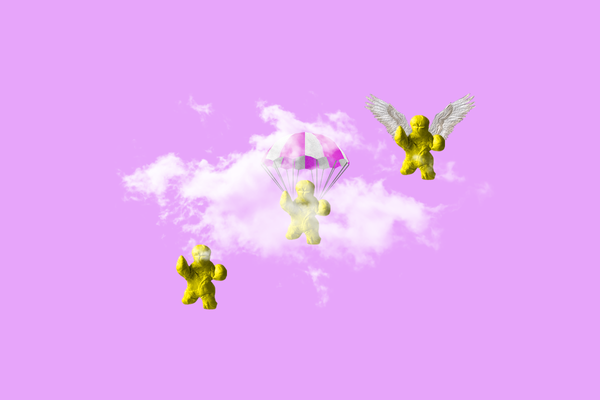Getting clipped up
Why do we make skate videos?

How do you catch a shadow? The place where light once lay is but an abstraction, a memory that struggles to stay put. It loses tense with each move we make, slippery real-time evidence of our existence in this world that our hands are not nimble enough to grasp.
We figured it out, though. Of course we did. We’re the ones who made sand resemble the surface of water — nothing can escape our desire to hold onto ourselves. So now there it is, and there we are, us and our shadows in photographs and film reels. We turned experience into an object. And once we figured out how to make our past captive in this way, we couldn’t stop.
And why would we? This subversion of time is a defiant act of beauty. The ability to stop and look at how we are and were, to see love we shared then, even if we’re barren now. We’d always been working towards this. Painting. Sculpting. Writing. Art as a complementary means of time travel and constriction. Soon everyone would have the ability to snare a memory and hang it on a wall or store it in a cloud.
Like our shadows, these captive memories became abstractions — parts of ourselves, yet separate from ourselves. Things to play with, to curate. We began searching for victories and failures, moments to lug home and stitch together. It's a pastiche of memory, sure. But also something more. We use them to harness emotion and aim it at an audience. Experience became an object, but an object that inspired an experience.
On a late September afternoon, that experience was a tortuous one. I’d spent four-and-a-half hours trying to land a trick on my skateboard. My friend stood nearby with a video camera pointed at the obstacle I’d rush up and fall down some three hundred times that day. I was so steadfast in my resolve to suffer because this was a trick, a moment, I wanted evidence of. That I needed desperately for myself and to share it with others. This trick was part of a collective vanity worth destroying oneself over. One we’d spent our lives watching and emulating.
That is, we were making a skate video.
Regarding what’s written above, this is one of the things skateboarding can do to a person: it transforms your thoughts, words, and actions into the deliriously overwrought. Your mind becomes consumed with this thing. With doing it. With capturing it. This bullheaded desire to see yourself triumph can cause a sort of mental break, a void that is at once bliss and merciless and can leave you in a state of motivated anguish for days, months, or years until you realize success — its hold broken by simply riding away.
But that’s just passion, after all. What else would drive people to spend all that time skateboarding, filming said skateboarding, and editing that skateboarding into wondrously packaged pieces of visual art? It’s a practice that professional skateboarder Walker Ryan has dedicated most of his adult life to it. Across two decades, Ryan estimates he’s been involved in twenty separate video projects where he considers himself to have had a “proper video part.” That’s in addition to dozens of tour and travel videos, a few dozen more commercials, “skatepark edits,” and countless one-minute-long Instagram clips.
While that tracks with someone who’s made a career out of riding a skateboard for as long as he has, it’s still an absurd, almost incalculable amount of time spent in front of a camera attempting and succeeding to film tricks on a skateboard. When framed like this, it might lead one to ask: why?
For Ryan, “It’s satisfying to capture yourself learning something new. Watching yourself and others also helps you improve. You can watch your mistakes or study the techniques of others. There’s also the continued emulation of the pro skaters you watch — along with a good deal of narcissism. For whatever reason, skateboarders just really like to watch themselves.”
It’s part of a profoundly ingrained custom of self-documentation that skateboarder and sociologist Dr. Paul O’Connor explores in his book Skateboarding and Religion, describing skate videos as “video journeys [that] become text for skateboarders, something to share with others, and in the process build and extend their communities.”
The creation of those texts stretches back to the sport’s popular origins. Skateboarding has appeared on film since at least the 1960s, with the Oscar-nominated short film Skaterdater (1965) often credited as being the first skate video. The short depicts a growing rivalry between two young friends who share a romantic crush, the only way this contention can be settled is by a duel of on-board ability. While a neat historical footnote, I would not consider Skaterdater a “skate video,” not in the sense of what we now understand them to be.
The first, by all accounts, is The Bones Brigade Video Show (1984). The Powell Peralta film established the framework of what the modern skate video would be: a piece of promotional material that showcases the act of skateboarding in service of selling a product. It’s a somewhat strange existential thought that the majority of our shared cultural touchstones, the videos that created the heroes and icons that we know today, in which the tricks that the skateboarders featured in them risked their health and safety to do, were made by companies looking to sell their wares.
It’s an understood part of the job description for the professional skateboarder, as Ryan notes when explaining his role in the industry, “For the past twenty years, I guess I’ve been the subject of promotional videos for brands.”
Of course, that doesn’t mean money is the only motivation or there isn’t genuine craft or passion behind the branded skate videos that drive the industry and culture. They’ve become touchstones for a reason. O’Connor writes that in those videos’ “efforts to provide an authentic representation of skateboard culture,” they offer some viewers a significant, “transformative,” and “transcendental” experience, which is probably why Sight Unseen (2001) still makes me inexplicably well up with each watch all these years later.
The fact that these videos are marketing tools is just a part of our capitalist reality. How do you sell something if you don’t promote it? And with an activity that needs rampant consumerism to survive, as skateboarding does, if skateboards weren’t marketed and sold successfully, people wouldn’t skate, and we wouldn’t be here now writing and reading about its history.
Jim Fitzpatrick is someone who knows this intimately. In the early 1960s, at 13 years old, he was a sponsored surfer tasked with promoting companies like Con and Dave Sweet Surfboards. While skateboards had existed in their nascent form for a number of years (Fitzpatrick himself “built a “self-made steel-wheeled skateboard in 1957”), they were still very much a novelty and one that hadn’t gained much traction beyond the United States.
In 1964, Bill Cleary of Makaha Skateboards would send Fitzpatrick to Europe with 12 clay-wheeled boards on a defacto promotional missionary tour, where he “skateboarded wherever I could.” Because what is more convincing as a marketing tactic than seeing someone actually skateboard? It’s a promotional principle Fitzpatrick would continue to follow twenty-some years later. By then, experienced in film production, he would become one of the architects of modern skateboarding media while working for Powell Peralta. He’d have his hands on everything from the brand’s “Intelligence Reports” (Powell Peralta-centric zines) to the production of their era-defining videos.
When I asked why he thought the documentation of skateboarding is so integral to skateboarding culture, he said it’s always been a matter of changing perceptions.
“From my earliest experiences in the 1950s, people who skateboarded understood [and] those who didn't didn't. 'Why are you doing that?' It's fun. "That's stupid!' You're stupid… In Europe during my '64 trek, people had no idea. They thought I was a magician. Kids wanted to try immediately.”
Once outlets like TransWorld Skateboarding Magazine, Thrasher Magazine, and Action Now were available, Fitzpatrick says it helped establish an appealing “mystique” around skateboarding while also “de-mystifying some of the details about tricks and how-tos,” which made it more accessible.
But there was a seismic shift once attention was turned to home video. “Stacy [Peralta] and Craig [Stecyk's] early efforts to create the home VHS video experience changed how skateboarding was perceived. [As] Paul Schmitt once said, ‘Perception is everything.’ Skate videos with a pause button and replay meant the world would never be the same.”
“Today,” Fitzpatrick says, “it's difficult to understand how primitive our communication was, but the incremental steps forward now provide streaming, televised events, Olympic events.” Before that, the game changer was, “Can we see that again?”
Later on, in his skateboarding-related advocacy work as the founder and Executive Director of the International Association of Skateboard Companies (IASC), Fitzpatrick pushed to change liability laws to open the door for public skateparks. While giving presentations to city councils and California State Legislators, he’d speak over highlight reels of old Powell Peralta videos. According to Fitzpatrick, witnessing these feats helped convince non-skateboarders of skateboarding’s legitimacy.
“Seeing is believing, and videos provided convincing evidence that skateboarders were doing something that seemingly defied reason.”
In a sense, that’s what we all continue to use the medium for now. A skate video is just evidence we share with each other of our collective reason defied.
While it may be impossible to decouple a branded skate video from the reality that it is functionally a commercial, there is a crucial difference: has the GEICO gecko ever inspired a generation of kids to dress, act, speak, and ride a skateboard a certain way? To spend years of their lives making a video of their own? Doubtful.
For filmmaker Shari White, who’s behind Vans Footwear projects like Credits and Keepsake, that inspiration is her motivation and a part of our shared desire for “gratification,” she says. It’s that feeling you get from creating something you’re proud of and seeing how people react to the finished product. But “doing it for yourself [first]” is paramount, even when working for behemoths like Vans. That’s reflected in White’s filmmaking, which has a distinct emotional timbre. It’s warm, reverent, and makes a point to focus on those who simply “look cool as hell on a skateboard.”
Ultimately, the filmmaker's vision is what gives a project heart and authenticity, qualities that skateboarders generally recognize and gravitate toward. That vision often helps aspiring professional skateboarders get a foothold in the industry. Walker Ryan says that working with an experienced videographer changed the course of his career.
“The first video I was a part of where there was a hired filmer who knew what he was doing with a video camera (in this case a VX1000) made a massive difference in how I was captured and then projected. For the first time in my life, the tricks I was doing looked like real tricks. That video really catapulted my skateboarding career, probably because I appeared more professional-looking thanks to the filmer.”
But filming is “only half the project.” The editing suite is where a project’s heart gets pieced together, beat by beat. For Ryan, music can make or break a project and “broaden [a video’s] cultural impact, relatability, and rewatch-ability… editing is so important.”
A filmer and editor with an original, authentic vision wields serious power. You can see it in Bill Strobeck's influence. The frantic zooms and purposefully overdrawn and dramatic edits that defined Supreme’s Cherry and “Blessed,” while cliched now, became adopted almost industry-wide because of their impact and emotional resonance. Like Strobeck, that White cultivated a distinct vision of her own while under the auspices of a multi-billion dollar corporation is notable. Especially since it’s something she got to do with her friends.
Ryan posits that’s the real creative life force pumping through the piecemeal heart of the skate video. “I would say that filming skateboarding, whether you’re the skater or the filmer, is one of the most rewarding creative, collaborative experiences. Removing any ‘marketing’ or ‘promotional’ aspect of the practice, filming something with your friend is just incredibly fun.”
Even if it’s torture. When you spend so long trying and failing that you lose your understanding of space, time, and consciousness, only coming to once you get dapped up by your pals in celebration. That feeling of individual accomplishment and earnest, honest camaraderie is unique to skateboarding but available to anyone with access to a camera and a skateboard.
Whether ambassadors for a multi-national conglomerate or a group of small-town chums, all are welcome to collect proof of their victories, defeats, good times, and friendships. To fit it all together with a common purpose and turn their experience into an object that begets an experience ad infinitum. You just need to be willing to spend hours, days, years suffering and smiling. To grow delirious with frustration and joy as you capture those moments, most mere seconds. Then you sift through them like silt until your timeline rattles with only choice nuggets. And finally, you tweak and twist until your shadows become long, ready, real — something to take in your hand and expose to the light.





